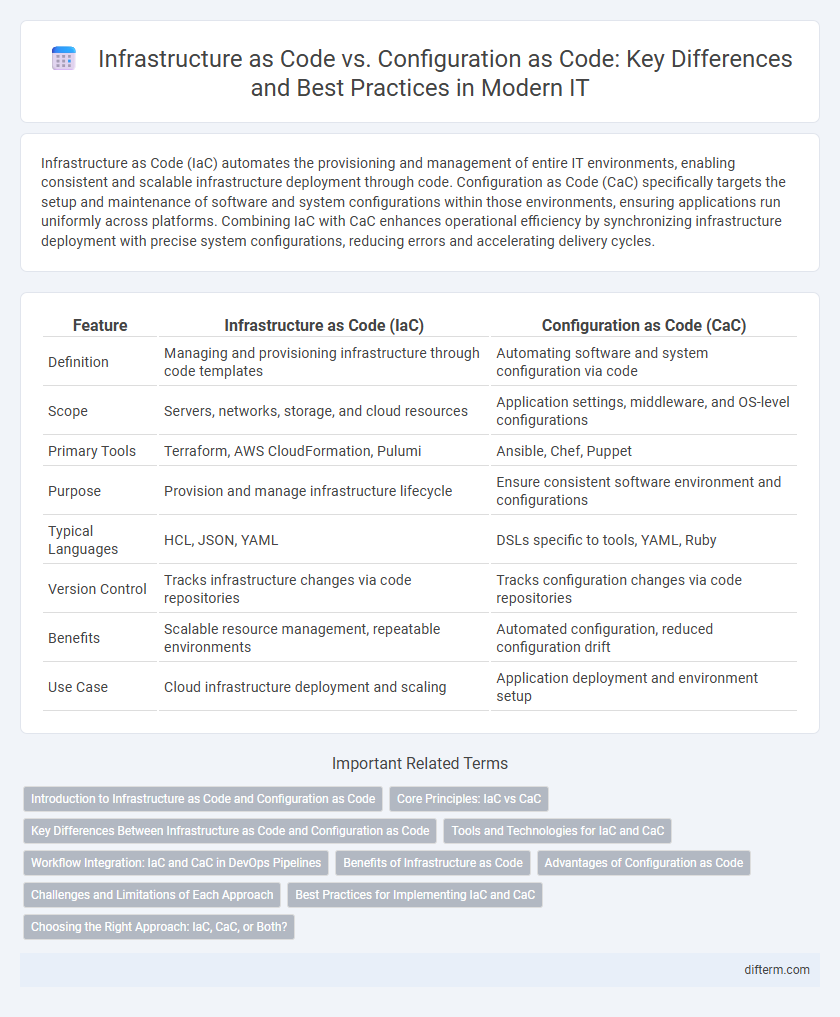Infrastructure as Code (IaC) automates the provisioning and management of entire IT environments, enabling consistent and scalable infrastructure deployment through code. Configuration as Code (CaC) specifically targets the setup and maintenance of software and system configurations within those environments, ensuring applications run uniformly across platforms. Combining IaC with CaC enhances operational efficiency by synchronizing infrastructure deployment with precise system configurations, reducing errors and accelerating delivery cycles.
Table of Comparison
| Feature | Infrastructure as Code (IaC) | Configuration as Code (CaC) |
|---|---|---|
| Definition | Managing and provisioning infrastructure through code templates | Automating software and system configuration via code |
| Scope | Servers, networks, storage, and cloud resources | Application settings, middleware, and OS-level configurations |
| Primary Tools | Terraform, AWS CloudFormation, Pulumi | Ansible, Chef, Puppet |
| Purpose | Provision and manage infrastructure lifecycle | Ensure consistent software environment and configurations |
| Typical Languages | HCL, JSON, YAML | DSLs specific to tools, YAML, Ruby |
| Version Control | Tracks infrastructure changes via code repositories | Tracks configuration changes via code repositories |
| Benefits | Scalable resource management, repeatable environments | Automated configuration, reduced configuration drift |
| Use Case | Cloud infrastructure deployment and scaling | Application deployment and environment setup |
Introduction to Infrastructure as Code and Configuration as Code
Infrastructure as Code (IaC) enables the management and provisioning of computing infrastructure through machine-readable definition files, automating the setup of servers, networks, and storage. Configuration as Code (CaC) focuses on maintaining consistent system configurations by defining software and application settings within version-controlled files. Both approaches improve deployment agility and system reliability by integrating automation and version control into IT infrastructure and configuration management.
Core Principles: IaC vs CaC
Infrastructure as Code (IaC) automates the provisioning and management of infrastructure using declarative configuration files to ensure consistency and scalability across environments. Configuration as Code (CaC) focuses on managing application and system configurations by applying version-controlled scripts or manifests to maintain desired states and reduce configuration drift. Both IaC and CaC emphasize automation, repeatability, and version control, but IaC targets infrastructure resources while CaC primarily manages software and service configurations.
Key Differences Between Infrastructure as Code and Configuration as Code
Infrastructure as Code (IaC) automates the provisioning and management of entire IT infrastructure, including servers, networks, and storage, whereas Configuration as Code (CaC) focuses on managing software settings and application environments on existing infrastructure. IaC tools like Terraform and AWS CloudFormation deal with infrastructure lifecycle, while CaC tools such as Ansible and Puppet handle application configuration and system state. The key difference lies in IaC establishing the foundational infrastructure, whereas CaC ensures consistent software deployment and configuration across that infrastructure.
Tools and Technologies for IaC and CaC
Terraform, Ansible, and AWS CloudFormation dominate Infrastructure as Code (IaC) by enabling automated provisioning and management of cloud resources through declarative configuration files. Configuration as Code (CaC) tools such as Puppet, Chef, and SaltStack focus on automating software installation, system configurations, and application management on already provisioned infrastructure. Both IaC and CaC integrate with CI/CD pipelines and support version control, but IaC tools primarily manage infrastructure lifecycle, while CaC tools fine-tune the operating environment and application state.
Workflow Integration: IaC and CaC in DevOps Pipelines
Infrastructure as Code (IaC) automates the provisioning and management of infrastructure resources using declarative configuration files, enabling seamless integration into continuous integration and continuous deployment (CI/CD) pipelines. Configuration as Code (CaC) focuses on managing software and system configurations, ensuring environment consistency and rapid deployment across development, testing, and production stages. Both IaC and CaC streamline DevOps workflows by enabling version-controlled, repeatable, and automated processes that reduce configuration drift and accelerate delivery cycles.
Benefits of Infrastructure as Code
Infrastructure as Code (IaC) enables automated provisioning and management of cloud resources, significantly reducing manual errors and deployment times. It provides consistent and version-controlled environments, ensuring infrastructure reproducibility and easier rollback of changes. IaC improves collaboration between development and operations teams by using declarative scripts, enhancing scalability and operational efficiency in complex systems.
Advantages of Configuration as Code
Configuration as Code offers improved consistency and faster deployment by automating the management of system settings and application configurations, reducing human errors. It enhances collaboration through version-controlled configuration files, enabling teams to track changes and maintain audit trails effortlessly. Integration with continuous integration/continuous deployment (CI/CD) pipelines ensures streamlined updates and scalability across diverse environments.
Challenges and Limitations of Each Approach
Infrastructure as Code (IaC) faces challenges such as managing complex dependencies across multi-cloud environments and ensuring idempotency during resource provisioning, which can lead to configuration drifts if not properly automated. Configuration as Code (CaC) struggles with limitations in version control granularity and difficulties in managing dynamic application settings that change frequently at runtime. Both approaches require robust testing frameworks to mitigate risks of misconfigurations and downtime in production systems.
Best Practices for Implementing IaC and CaC
Implementing Infrastructure as Code (IaC) and Configuration as Code (CaC) effectively requires adopting best practices such as modular and reusable code structures to increase maintainability and reduce errors. Automated testing and continuous integration pipelines ensure that infrastructure changes and configuration updates are validated before deployment, minimizing downtime and security risks. Leveraging version control systems enhances collaboration and auditability, enabling teams to track modifications and rollback changes when necessary.
Choosing the Right Approach: IaC, CaC, or Both?
Infrastructure as Code (IaC) automates provisioning and managing infrastructure through declarative scripts, while Configuration as Code (CaC) focuses on automating software and system settings configuration. Choosing the right approach depends on project scale and complexity; IaC suits dynamic environments requiring consistent infrastructure deployment, whereas CaC excels in managing application-level configurations and system states. Combining IaC and CaC leverages comprehensive automation, ensuring infrastructure setup and configuration management achieve seamless integration and operational efficiency.
Infrastructure as Code vs Configuration as Code Infographic

 difterm.com
difterm.com